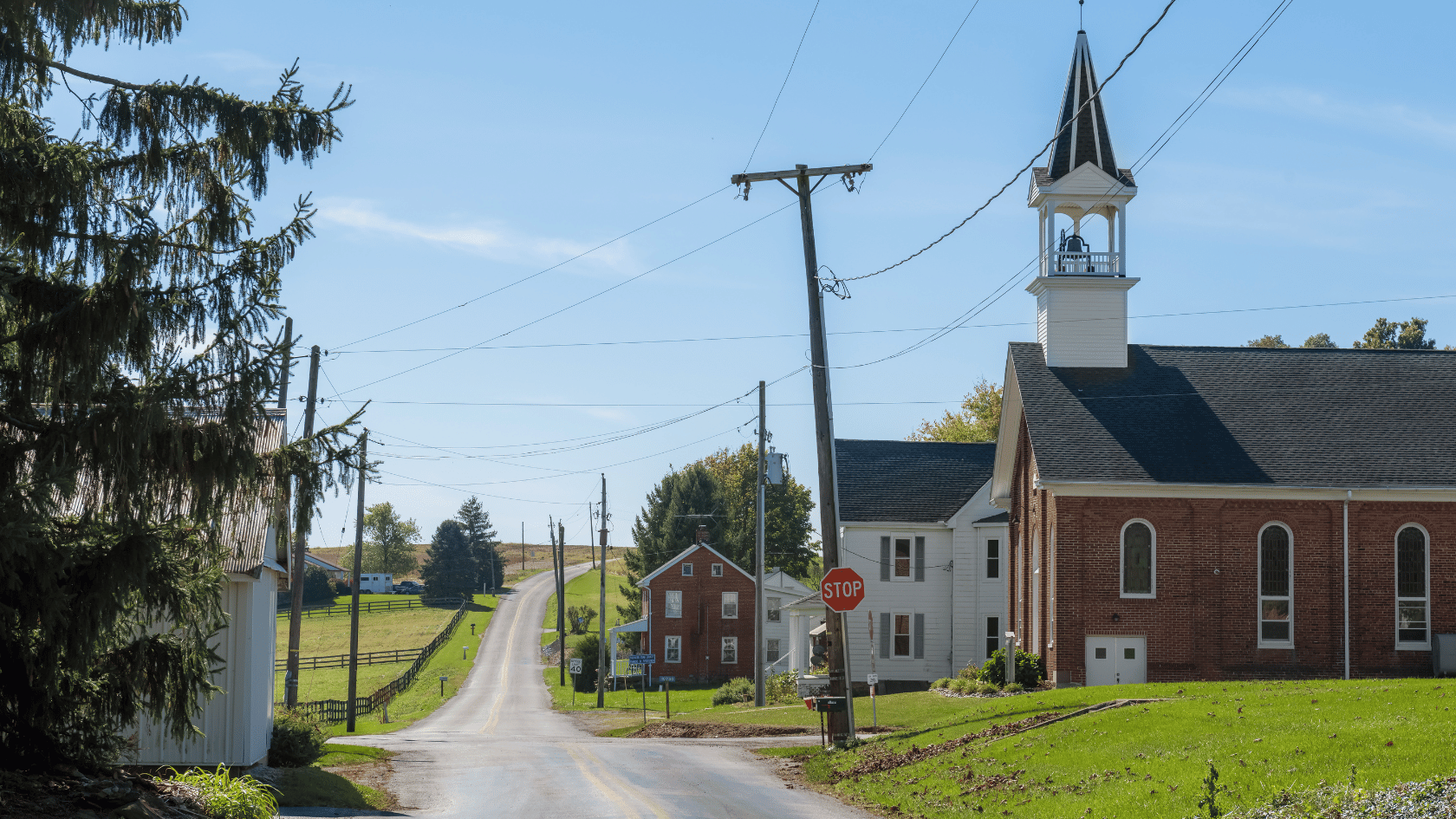1. Smicksburg, PA
Nestled in Indiana County, Smicksburg is renowned for its Amish population and their traditional way of life. This tiny town, with a population of just 56, offers visitors an authentic glimpse into Amish culture. Specialty shops selling Amish crafts, furniture, and baked goods line the streets, while seasonal festivals celebrate the town’s heritage. The surrounding countryside, with its Amish farms and quiet lanes, adds to the town’s tranquil appeal.
2. Centralia, PA
Perhaps Pennsylvania’s most infamous small town, Centralia has been nearly abandoned due to an underground mine fire that has been burning since the 1960s. Once a thriving community, its population has dwindled to a handful of residents. The town’s eerie, smoke-filled landscape and cracked, graffiti-covered highway attract curious visitors and photographers drawn to its apocalyptic ambiance.
3. Ricketts Glen, PA
Although not a town but rather a state park area, Ricketts Glen is home to a few residents and is best known for its stunning natural beauty. The park features over 20 waterfalls along a scenic hiking trail, old-growth forests, and a variety of outdoor activities, making it a favorite among nature enthusiasts.
4. Scalp Level, PA
With a name as unique as its history, Scalp Level is a small borough in Cambria County. It gained its name from a local legend and was once known for its artists’ colony in the late 19th century, attracted by the picturesque landscapes. Today, it remains a quiet community with a population of just a few hundred, offering a peaceful retreat.
5. S.N.P.J., PA
Short for Slovenska Narodna Podporna Jednota, S.N.P.J. is a borough in Lawrence County established as a recreational area by a Slovenian fraternal organization. It holds the distinction of being one of the smallest incorporated boroughs in the state by population. The town is essentially a private resort, offering various recreational facilities and events for its members.
6. Glen Campbell, PA
Named not after the singer but a railroad official, Glen Campbell is a tiny borough in Indiana County. This small town, with a population of just a few hundred residents, offers a glimpse into rural Pennsylvania life, with historic homes and a close-knit community atmosphere.
7. Weedville, PA
Located in Elk County, Weedville is a small community within the larger area known as Jay Township. It’s known for its proximity to natural attractions, including the Elk State Forest and several state parks, making it a base for wildlife viewing, particularly elk, and outdoor activities.
8. Grindstone, PA
Grindstone is a small community in Fayette County, reflecting the region’s coal mining heritage. Though the mines have long since closed, the town retains a quiet charm, with historic homes and the beautiful landscape of the Laurel Highlands nearby.
9. Paradox, PA
While not officially recognized as a municipality, Paradox is a small community with a quirky name that captures the imagination. It’s representative of the numerous tiny hamlets scattered across Pennsylvania, each with its unique story and character.
10. Modena, PA
A small borough in Chester County, Modena is home to a few hundred people and offers a slice of quiet, small-town life amidst the rolling hills of southeastern Pennsylvania. Its history, tied to the nearby Brandywine Creek, includes early industrial and agricultural development.
These towns, each with their distinct character, embody the quiet charm and hidden stories of Pennsylvania’s less traveled paths. From the haunting allure of Centralia to the scenic beauty of Ricketts Glen and the intimate community life in places like Glen Campbell and Weedville, these small towns invite curiosity and exploration beyond the state’s larger cities and tourist spots.
Pennsylvania, a state rich in history, natural beauty, and cultural diversity, is often celebrated for its major cities like Philadelphia and Pittsburgh. However, beyond the bustling city life lies a mosaic of small towns, each holding its unique allure. These hidden gems offer a serene escape into the heart of America, showcasing the state’s soul through their quiet streets, historic landmarks, and the warmth of community life. Here’s why you should consider visiting the small towns of Pennsylvania on your next journey.
1. Step Back in Time
Visiting small towns in Pennsylvania is akin to stepping into a living history book. Places like Smicksburg, with its Amish community, offer a glimpse into a way of life preserved over centuries. Meanwhile, the nearly abandoned town of Centralia tells a different story, with its eerie landscape offering a haunting reminder of the past. Each town, whether defined by its historical significance or unique circumstances, invites visitors to explore and appreciate the layers of history that have shaped them.
2. Experience Local Culture and Traditions
Small towns are the heartbeat of Pennsylvania’s cultural heritage. They provide a platform to experience local traditions, festivals, and customs firsthand. From the Slovenian heritage celebrated in S.N.P.J. to the artistic legacy of Scalp Level, these communities take pride in their heritage, offering festivals, museums, and local eateries that reflect their cultural richness and culinary diversity.
3. Natural Beauty and Outdoor Adventures
The scenic beauty of Pennsylvania’s countryside is best experienced in its small towns. Ricketts Glen, with its breathtaking waterfalls and hiking trails, exemplifies the state’s natural wonders. Whether it’s the rolling hills of the Laurel Highlands near Grindstone or the wildlife viewing opportunities in Weedville, small towns offer an abundance of outdoor activities for nature lovers, from hiking and biking to fishing and wildlife observation.
4. Unique Shopping and Culinary Delights
Small towns in Pennsylvania are treasure troves of unique shopping experiences and culinary delights. Artisan shops in Smicksburg sell Amish-made goods, while local markets across these towns offer homemade treats and handcrafted items not found elsewhere. Dining in these towns also means savoring local flavors, from traditional Pennsylvania Dutch dishes to contemporary cuisine made with locally sourced ingredients.
5. Warm Hospitality and Peaceful Retreats
Perhaps the most compelling reason to visit small towns is the genuine hospitality of their residents. Away from the crowded tourist spots, these communities welcome visitors with open arms, offering cozy bed and breakfast accommodations, friendly local eateries, and a chance to be part of the community, if only for a while. The peaceful atmosphere provides a perfect backdrop for relaxation and reflection.
6. Educational Opportunities
Small towns offer educational experiences that are both enriching and engaging. Learning about the Amish way of life in Smicksburg, understanding the coal mining heritage of places like Glen Campbell, or exploring the environmental history around Centralia can add depth to any Pennsylvania visit. These towns offer a hands-on learning experience about the state’s ecological, industrial, and cultural history.
Conclusion
The small towns of Pennsylvania are where the state’s heart truly lies. They offer a unique blend of history, culture, natural beauty, and hospitality that you’d be hard-pressed to find in larger cities. Visiting these towns not only provides a deeper understanding of Pennsylvania’s past and present but also supports the local economies and preserves the unique heritage of these communities. So, next time you’re planning a trip, consider taking the road less traveled and explore the charming small towns of Pennsylvania. You might just find yourself falling in love with the hidden gems that make this state truly special.
FAQ: Exploring Small Towns in Pennsylvania
1. Why should I visit small towns in Pennsylvania? Small towns in Pennsylvania offer a unique blend of history, culture, natural beauty, and hospitality. They provide a serene escape from the hustle and bustle of city life, allowing visitors to experience a different pace of life, explore historical landmarks, enjoy local traditions, and immerse themselves in the scenic beauty of Pennsylvania’s countryside.
2. What can I learn from visiting towns like Smicksburg and Centralia? Visiting Smicksburg offers insights into the Amish way of life, showcasing traditional crafts and customs. Centralia presents a different learning experience, with its almost ghost-town status due to an underground mine fire, teaching visitors about the impacts of industrial activities on small communities.
3. Are small towns in Pennsylvania suitable for outdoor activities? Yes, many small towns like Ricketts Glen are gateways to outdoor adventures, offering opportunities for hiking, wildlife viewing, fishing, and exploring state parks and natural attractions. The diverse landscapes surrounding these towns provide a playground for nature lovers and adventure seekers.
4. What unique shopping and dining experiences can I find in these towns? Small towns in Pennsylvania are home to unique shops selling handcrafted goods, Amish-made furniture, artisan products, and local culinary delights. Dining in these towns often means experiencing farm-to-table meals, traditional dishes, and family-owned eateries that offer a personal touch.
5. How do small towns in Pennsylvania preserve their cultural heritage? Through festivals, museums, local markets, and community events, small towns celebrate and preserve their cultural heritage. This includes showcasing local crafts, traditions, culinary arts, and historical narratives, inviting visitors to learn about and participate in their rich cultural tapestry.
6. Can visiting small towns in Pennsylvania offer educational opportunities? Absolutely. Small towns provide educational experiences through museums, historic sites, guided tours, and interactive experiences that delve into the state’s history, culture, and natural environment, making learning engaging and accessible for all ages.
7. What makes small towns like Glen Campbell and Weedville worth visiting? Towns like Glen Campbell offer insights into Pennsylvania’s coal mining history, while Weedville provides access to wildlife viewing in the Elk State Forest. Each town has its unique story, attractions, and natural beauty, making them worth exploring for a deeper understanding of the state’s diverse heritage.
8. Are there accommodations available in these small towns? Many small towns offer cozy accommodations, including bed and breakfasts, inns, and guesthouses, providing a warm and welcoming experience. These accommodations often reflect the town’s character and offer a personal touch to your stay.
9. How can visiting small towns in Pennsylvania support local communities? Visiting these towns supports local economies by bringing business to small shops, eateries, and accommodations. It also helps preserve the towns’ heritage and cultural sites, ensuring they remain vibrant parts of Pennsylvania’s landscape.
10. How do I choose which small towns to visit in Pennsylvania? Consider your interests, whether it’s history, nature, culture, or outdoor activities. Research towns that offer experiences aligning with your interests, and plan your visit around local events or attractions that pique your curiosity. Each town has something unique to offer, making your visit a personal adventure.

